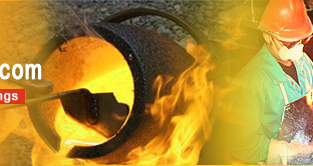Introduction: Cosworth process was developed by Dr. Campbell, at the instance of Mr. Cosworth a performance engine-manufacturer, who wanted a suitable process of high-integrity

aluminum casting. The name cosworth is now synonymous with racing car engines. Since the development of the process in 1987, it has been adopted by many foundries. The American Foundrymen's Association has identified the cosworth process as the best emerging process that can be commercialized.
Cosworth process is a modern foundry process where zircon sand is used instead of silicon for making sand molds. And, counter-gravity pouring technique is used to force the metal into the mold. The famous automobile manufacturers 'The Ford' selected the process for its windston, ontario plant.
Process: The sand casting process is used to prepare the mold for
cosworth process. But, instead of silicon, zircon is used as the aggregate. When the mold is prepared the molten metal is forced into the mold from the base, using the gravity technique. No gating and feeder are used for the metal pouring purpose, therefore blow holes from chill, cores and adhesives are not created as in conventional pouring methods.
Cosworth process uses precision sand casting method. In precision casting the mold is preheated and cooled, in order to obtain a variation of temperature throughout the mold.
This process helps is avoiding shrink holes and blow holes. The precision sand casting process uses cold-box coremaking techniques which eliminated the dimensional issues created by the hot-cured cores.
 Application:
Application: The
cosworth process is used to cast non-ferrous casting for medium to high production. The process is being used for casting component mainly for aerospace and defense industries like helicopter engines, helicopter winch drums, high pressure refueling manifolds for tanker aircraft, gun cradles, aluminum structural parts for airframes and marine engines, etc.
Advantages:
- Casting have high integrity and dimensional issues
- No porosity formed therefore the castings are pressure tight
- Best suitable for high-integrity aluminum castings
- Improved metallurgical and mechanical properties
- Reduces fettling time and machining required
- Thinner section can be cast allowing the design of lighter, more robust components
- High strength and ductility for the casted products.


